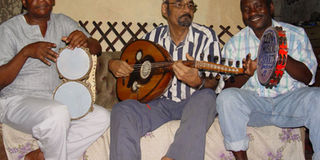Zein l’Abdin Ahmed is the coastal lute player who popularised taarab

Zein I’Abdin Ahmed Alamoody (centre) with his fellow taarab musicians Omar Swaleh (left) and Anasi Mbwana in Mombasa. Zein I’Aadbin Ahmed Alamoody died on June 27. PHOTO | ANDREW EISENBERG
What you need to know:
- An inventive composer and virtuoso performer of the Arabic oud (lute), Zein helped to shape the sounds of Swahili taarab in Kenya and beyond for more than half a century.
- In 1956, Zein joined the famed Jauhar Orchestra, which had developed a “Swahili” style redolent with Arab and Latin (and a touch of Indian) sounds. His tenure with this group was brief, however.
- After being denied the opportunity to participate in an historic performance for the Sultan of Zanzibar, he resigned.
On June 27, renowned Swahili poet, singer, multi-instrumentalist and band leader Zein l’Abdin Ahmed Alamoody passed away at his home in the Old Town of Mombasa, leaving behind a widow, six daughters from two previous marriages, and 10 grandchildren.
An inventive composer and virtuoso performer of the Arabic oud (lute), Zein helped to shape the sounds of Swahili taarab in Kenya and beyond for more than half a century.
Born on Lamu Island in 1939, Zein was first exposed to the intersecting worlds of Arab and Swahili music during his childhood. His father, an amateur musician, owned a collection of Arab and Swahili records and regularly hosted gatherings with local and visiting musicians, including oud virtuoso Ali Baskuta (Zein’s maternal uncle) and Kuwaiti performers brought in by a local shipping magnate.
When Zein moved to Mombasa after his father’s death in the late 1950s, he was not yet a musician, but he brought with him an oud that he had borrowed from a family member. Much like his father, he worked at the port during the day and hang out with musicians in the evenings.
He learned what he could from the experienced musicians who were around; but he also derived a great deal of knowledge from recordings, especially those of legendary Syrian Druze musician Farid el-Atrash, an oud virtuoso whom Zein liked to call his “mwalimu.”
ARABIC TAARAB
After a few years of study, Zein began playing music professionally. The local music scene in Mombasa during the 1950s was dominated by sharply dressed, all-male taarab orchestras that would perform for weddings, social events, and radio shows, and sometimes record for Assanand & Sons’ Mzuri label.
In 1956, Zein joined the famed Jauhar Orchestra, which had developed a “Swahili” style redolent with Arab and Latin (and a touch of Indian) sounds. His tenure with this group was brief, however. After being denied the opportunity to participate in an historic performance for the Sultan of Zanzibar, he resigned.
He next joined up with Lamuan poet and musician Ali wa Lela, who had learned to play the oud at Zein’s father’s house in the 1940s. But that gig did not last long, either, as Ali soon departed for a job opportunity in the UAE.
After Ali wa Lela’s departure, Zein went solo. By the early 1970s he had put out a number of singles, including some that feature two other singers who would go on to become big taarab stars, Zuhura Swaleh and Maulidi Juma. In the late 1970s, he began putting out full albums on cassette through the major taarab outlet of the time, Mombasa’s Mbwana Radio Services.
Early on in his solo career, Zein followed the trend of the day by working in an “Indian” style, setting his Swahili poetry to melodies drawn from popular Hindi film songs. But he soon abandoned that direction in favour of a style that came to be popularly known as taarab ya kiarabu, “Arabic taarab.” Instead of Bollywood melodies, he began using Arab melodies — existing and newly composed — resulting in a style that harked back to what he had been exposed to in his father’s house.
CULTURAL TREASURE
Zein honed his Arabic taarab — or as he sometimes preferred to call it, “utungaji wa zamani,” the old style of composition — in collaboration with Swahili poet and scholar Ahmed Sheikh Nabhany.
The two men worked together during the 1970s to set old and new Swahili poems to melodies derived from the Arab modal system and rhythms derived from Egyptian tarab, Kuwaiti sawt, and Swahili ngoma. The resulting repertoire, which represents a high watermark of Swahili art, earned Zein the honorific “ustadh” among his Swahili admirers.
Zein’s Arabic taarab found a waiting audience in Mombasa in the 1970s, partly due to the influx of Hadhrami Arabs to the Kenyan coast in the 1960s.
The large number of Hadhrami-Swahili weddings created demand for music sung in Swahili, but performed kiarabu, in an Arab style (Zein also performed Yemeni songs in Arabic for Hadhrami men who preferred more traditional Hadhrami wedding celebrations).
While the local popularity of Arabic taarab has been on the wane since the 1980s, Zein’s reputation as a Swahili cultural treasure has only grown and spread. During the last few decades of his life, a steady stream of foreign students, scholars, and music industry professionals arrived at his door, eager to learn from him and work with him.
The tangible results of this have been concerts in Europe and the UAE as well as two international CD releases — Mtindo wa Mombasa (1989, Globestyle) and The Swahili Songbook (2000, Dizim Records), both of which contain detailed notes by German ethnomusicologist Werner Graebner.




